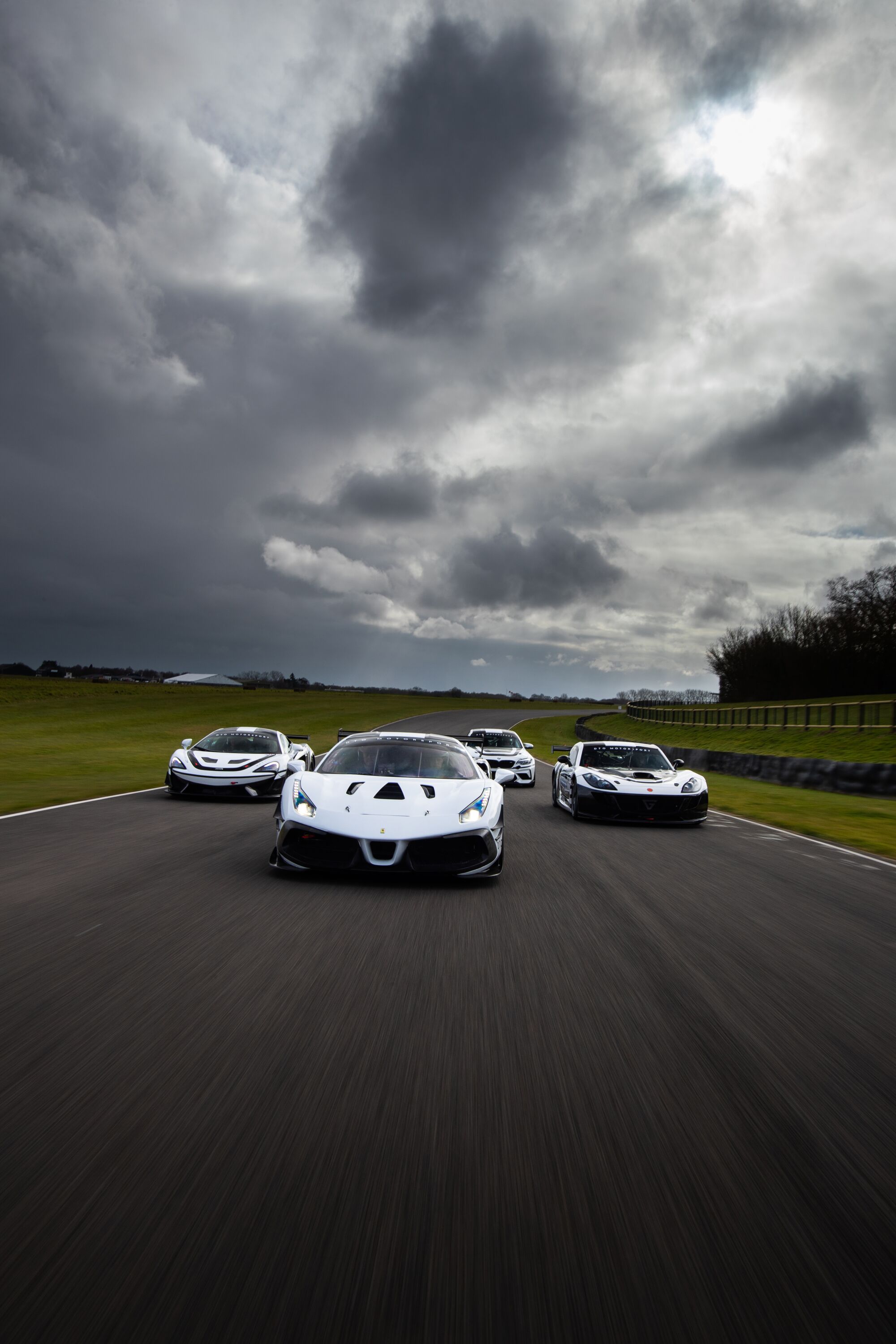Classic appeal revitalised – here are the New Classics at the Festival of Speed
There’s no escaping the fact that the automotive industry is currently in a state of flux. The uncertain march towards electrification is causing much head-scratching in boardrooms around the world.

Meanwhile, there’s a movement in parallel that’s gaining huge momentum. The rise of the restomod is a reaction to the accelerated progress mainstream corporations are making towards EVs. Suddenly there’s a great deal of appeal in taking the car industry’s greatest hits and updating them.
Are they new? Are they classics? They’re a bit of both, and the New Classics category, which is new for the 2025 Goodwood Festival of Speed presented by Mastercard, is the place to see them.
Eccentrica V12
The Eccentrica V12 is an effort to tame the devil. Taking the spiky Lamborghini Diablo as its base, it aims to refine its drivability, handling and power delivery to make it more approachable by those more accustomed to modern supercars. At the same time, the naturally-aspirated V12 engine is retained in all its (more subtly updated) glory.
Increasing power was never a priority, but it is up by 55PS (40kW) by dint of the changes made to tame its delivery. That includes new camshafts, a lighter flywheel, electronic throttle bodies and a new exhaust. It now drives through a six-speed gearbox (manual, as you’d hope...).
Changes beneath the skins are combined with a pretty comprehensive visual makeover. The distinctive cab-forward proportions shout Diablo, but there’s so much new detailing that the Eccentrica has a look that’s all its own. It’s the same story inside, where the Lamborghini origins have been thoroughly painted over. Eccentrica is going to build just 19 examples.

Alpine A110 R Ultime
This is something of an outlier in this category. Most of our New Classics come from specialist firms who have taken an existing classic and refreshed for the second quarter of the 21st century. The Alpine A110 R Ultime is instead the French firm’s modern interpretation of one of its own classics.
And what an interpretation it is. The lightweight two-seater has been a favourite of ours since it was released in 2017. For its swansong, the Alpine has devised the A110 R Ultime. Its familiar 1.8-litre turbocharged four-cylinder engine has been boosted to 394PS (256kW) kept in check by a host of aerodynamic additions to the classic inspired style.
Alpine will be making only 100 Ultimes, fifteen of them being the even more limited edition La Bleue edition. That one comes in a special colour scheme and a premium pricetag of £276,000. The other Ultimes? Relatively a snip at £221,000.
Analogue SuperSport
The Series 1 Lotus Elise is a modern classic in its own right. Venerated when new, it has only become more appealing with the march of time. Lightweight, precise and pared back in a way that modern cars simply aren’t, it’s a car of its time that appeals enormously to a certain audience.
Lotus specialist Analague Automotive recognises that, and with its SuperSport it has taken that platform and enhanced it rather than attempting to engender a whole new character. Each Supersport is stripped to a bare chassis and the suspension thoroughly refreshed. It’s also upgraded with CNC front hubs, Nitron Clubsport dampers, wider wishbones and a 25mm reduction in ride height.
The 1.8-litre Rover K-series engine remains, but now with hotter cams, bigger valves, throttle bodies and a carbon fibre airbox. The result is more than 200PS (147kW). There’s also a lighter flywheel, shorter gears and a limited-slip differential to sharpen performance. It’s still an Elise, then. Just more so.
Kimera K39, EVO38, EVO37, Lancia Beta Montecarlo Martini
Kimera brings not one but four Lancia derived New Classics to Goodwood. In fact, the range is so large that you’ll find them located in the Supercar Paddock rather than parked with the other New Classics.
The company was founded by Italian rally driver Luca Betti who went on to run a rally team and later began restoring classics. That led to creating his modernised interpretation of the Lancia 037, the last rear-wheel-drive car to win a World Rally Championship in an era when everyone else had moved on to four-wheel-drive.
Like the 037 Stradale homologation cars, Kimera’s reinterpretations are based on the more numerous Beta Montecarlo of which Lancia built around 8,000. The Lancia’s styling has responded well to being sympathetically updated, the new bodies being made from carbon-fibre. Like the original cars, the capacity is 2.1 litres, unlike the originals they are both turbo- and supercharged.
Porsche Lanzante 930 TAG Turbo
We’ve had a few years to get our heads around the concept of the Porsche Lanzante 930 TAG Turbo, but it still seems utterly insane. The short story: take a 1980s 911 and add a Porsche-developed TAG Formula 1 engine from the same era. That’s 1.5 litres of turbocharged craziness out behind the rear axle. It sounds like a fever dream, but Lanzante has made it a reality.
The first of 11 examples was shown in 2018, and this one is number nine of that run. Each one has a storied engine, and this one comes from the McLaren MP4/3 that Alain Prost drove to his 27th F1 win at Spa-Francorchamps in 1987. Cosworth has been enlisted to tame that screaming F1 engine for road use. It will still spin to 9,000rpm, though, while power has been turned down to 510PS (375kW). That’s more than enough to keep the lightweight 911 on its toes, and the driver too with that notoriously tricky on-limit handling of older 911s.
Restomod? New Classic? It’s pretty hard to put the Lanzante 930 TAG Turbo into a category because there’s really nothing else like it, barring another of the Lanzante 930 TAG Turbos.
Range Rover Classic by Lunaz
Lunaz takes classic cars and bestows upon them an EV drivetrain. The classic Range Rover is one of several offerings, but from the outside you’d be forgiven for thinking it’s simply a well kept classic SUV – aside from the subtle badging. That’s because Lunaz preserves the car’s original form on the outside so that the change of drivetrain is as discreet as it is quiet.
Inside, though, it’s far from classic Range Rover business as usual. While it’s as spacious and airy as ever, it is also thoroughly upgraded with new materials wherever you look. Lashings of leather and plentiful hand-finished wood elevate the ambience considerably, meaning the interior ambience is just as significant an upgrade as the batteries and motors. Each car is bespoke and Lunaz limits production to ensure the car’s ongoing exclusivity.
Roll-Royce Phantom V by Lunaz
Another classic model to receive the Lunaz treatment is the Rolls-Royce Phantom V. And even the most ardent EV cynic would surely concede that the silent progress of an electric motor suits the quiet progress of such a luxurious limousine.
The concept marries modern performance and reliability to the traditional craftsmanship that made Rolls-Royce’s name in the first place. Sir Henry Royce himself said, “Small things make perfection, and perfection is no small thing,” and that’s a principle that Lunaz aims to continue with its Phantom V rebirths to retain the look and feel of the original.
TWR Supercat
You can’t ignore the Jaguar XJS-based TWR Supercat, its brutal styling makeover sees to that. Quad headlights, aggressively pumped up wheelarches and distinctive side exhausts conspire to create a look that’s entirely it’s own. And those uncompromising looks are backed up with a 670PS (493kW) V12 engine that drives through a six-speed manual gearbox. Are you getting this impression that this is unapologetically old school? You’d be right.
TWR is a new entity, founded by Fergus Walkinshaw, son of Tom Walkinshaw. While it’s a new organisation, Walkinshaw junior is keen to ensure that it shares the spirit and DNA of his father’s storied race team. Porsche aficionado Magnus Walker has been recruited as a consultant, as has prolific social media digital render creator Khyzyl Saleem, to assist with the design and development of the Supercat.
There’s an immediate link with the Jaguar XJS, of course, while the total production number will be 88 to reflect TWR’s 1988 victory at the Le Mans 24-hour with the Jaguar XJR-9. They’re priced at £225,000 plus local taxes.

Wood and Pickett Mini by Callum
Modified Minis are nothing new – people have been stamping their individuality on Alec Issigonis’s masterpiece for decades. But this is new: a commercially available Mini re-imagining from former Jaguar designer Ian Callum. And it takes a classic name, too: Wood and Pickett was famous for making Minis more luxurious for the rich and famous. Maintaining that tradition, the first Wood and Pickett Mini by Callum has been built for David Gandy.
Its based on a Mini Mk5 Sportspack shell, but adds its own bodywork additions, bespoke wheels and new lighting. And brown paint. Inside, the transformation is even more thorough. Leather trim abounds, while a new dashboard incorporated modern touchscreen technology, the like of which would have been unimaginable when the Mini was new in 1959.
Each Wood and Pickett Mini by Callum will be tailored for the customer, production numbers are limited and the price starts from £75,000.
The 2025 Goodwood Festival of Speed is underway! You can watch every moment of the action by watching our livestream.
Photography by Joe Harding, Jordan Butters and Toby Whales.
FOS
FOS 2025
Festival of Speed 2025
New Classics
Lancia
Porsche
Rolls-Royce
Range Rover
Jaguar
Mini
Lotus
Event Coverage





























